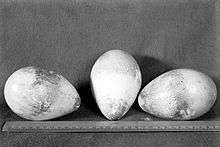Charles Wynford Parsons
Charles Wynford Parsons (born July 22, 1901 in Swansea , † August 26, 1950 in Birmingham ) was a British zoologist and long-time lecturer at the University of Glasgow .
Life
Parsons studied at St John's College , Cambridge between 1920 and 1924 , before becoming an assistant professor and then associate professor in the Department of Zoology at the University of Glasgow. He held this position until his death.
After Parsons had initially carried out studies on amoeba and published a scientific paper on this in 1926, he changed specialist areas under the influence of the institute's director John Graham Kerr and from then on made research contributions in the field of morphology and embryology of vertebrates . In one of his first works he dealt with comparative studies of the blood vessel system in fish .
In 1932 Parsons got the opportunity to carry out examinations on embryos of emperor penguins . These came from eggs that participants in the Discovery Expedition , led by polar explorer Robert Falcon Scott , had collected around 30 years earlier at Cape Crozier . In 1934, the results of embryological studies by zoologist James Cossar Ewart of the University of Edinburgh on hatched emperor penguin eggs, which Edward Wilson , Henry Bowers and Apsley Cherry-Garrard carried out on Scott's Terra Nova expedition during their winter march from July to August 1911, were published had also brought with them from Cape Crozier. Ewart had not been able to determine any homology in the embryonic development of the plumage of birds and the scale armor of reptiles , which means that the hoped-for proof of a common ancestor in the evolution of both animal classes failed to materialize. Parsons concluded that the emperor penguin eggs, laboriously procured at the risk of death for the polar researchers involved, "did not contribute very much to the understanding of the embryology of penguins."
In addition to his research work, Parsons held administrative and honorary functions at the University of Glasgow. He was an artillery major member of the University Officers' Training Corps , an army division of the British Army for the recruitment of soldiers from higher education. In addition, he was a member of the University Senate and held the office of Dean of the Faculty of Zoology three times . Parsons was also a member of the Royal Society of Edinburgh and was appointed to its governing body in 1933.
On his death, Parsons left behind his wife and four children.
literature
- Charles Maurice Yonge : Mr. CW Parsons . In: Nature , 1950, No. 166 (4223), pp. 587-588. PMID 14780160 .
Individual evidence
- ^ CW Parsons: Some observations on the behavior of amoeba proteus . In: Quarterly Journal of Microscopical Science , 1926, pp 2-70, pp 629-646.
- ^ CW Parsons: The Conus Arteriosus in Fishes . In: Quarterly Journal of Microscopical Science , 1929, pp 2-73, 145-176.
- ^ CW Parsons: Report on Penguin Embryos Collected During the Discovery Investigations (Discovery Reports). Cambridge University Press, Cambridge 1932.
- ↑ Apsley Cherry-Garrard: The Worst Journey in the World Vol. I , Constable & Co., London 1922, Appendix (English, accessed from the Internet Archive on February 19, 2013).
- ^ CW Parsons: Penguin Embryos, British Antarctic (Terra Nova) Expedition, 1910, Natural History Report . In: Zoology 4 (7), 1934, p. 253: "not greatly add to our understanding of penguin embryology."
| personal data | |
|---|---|
| SURNAME | Parsons, Charles Wynford |
| BRIEF DESCRIPTION | British zoologist |
| DATE OF BIRTH | July 22, 1901 |
| PLACE OF BIRTH | Swansea |
| DATE OF DEATH | August 26, 1950 |
| Place of death | Birmingham |
